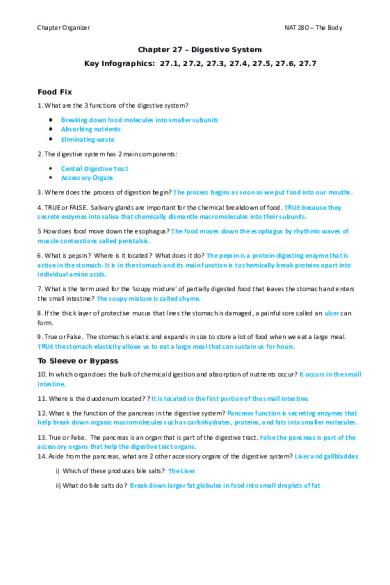Chapter 27-Digestive System-Organizer PDF

| Title | Chapter 27-Digestive System-Organizer |
|---|---|
| Course | The Body- Bits and Bites |
| Institution | Seneca College |
| Pages | 2 |
| File Size | 73.5 KB |
| File Type | |
| Total Downloads | 81 |
| Total Views | 155 |
Summary
Answers and notes...
Description
Chapter Organizer
NAT 280 – The Body Chapter 27 – Digestive System
Key Infographics: 27.1, 27.2, 27.3, 27.4, 27.5, 27.6, 27.7
Food Fix 1. What are the 3 functions of the digestive system?
Breaking down food molecules into smaller subunits Absorbing nutrients Eliminating waste
2. The digestive system has 2 main components:
Central Digestive Tract Accessory Organs
3. Where does the process of digestion begin? The process begins as soon as we put food into our mouths. 4. TRUE or FALSE. Salivary glands are important for the chemical breakdown of food. TRUE because they secrete enzymes into saliva that chemically dismantle macromolecules into their subunits. 5 How does food move down the esophagus? The food moves down the esophagus by rhythmic waves of muscle contractions called peristalsis. 6. What is pepsin? Where is it located? What does it do? The pepsin is a protein-digesting enzyme that is active in the stomach. It is in the stomach and its main function is to chemically break proteins apart into individual amino acids. 7. What is the term used for the ‘soupy mixture’ of partially digested food that leaves the stomach and enters the small intestine? The soupy mixture is called chyme. 8. If the thick layer of protective mucus that lines the stomach is damaged, a painful sore called an ulcer can form. 9. True or False. The stomach is elastic and expands in size to store a lot of food when we eat a large meal. TRUE the stomach elasticity allows us to eat a large meal that can sustain us for hours. To Sleeve or Bypass 10. In which organ does the bulk of chemical digestion and absorption of nutrients occur? It occurs in the small intestine. 11. Where is the duodenum located? ? It is located in the first portion of the small intestine. 12. What is the function of the pancreas in the digestive system? Pancreas function is secreting enzymes that help break down organic macromolecules such as carbohydrates, proteins, and fats into smaller molecules. 13. True or False. The pancreas is an organ that is part of the digestive tract. False the pancreas is part of the accessory organs that help the digestive tract organs. 14. Aside from the pancreas, what are 2 other accessory organs of the digestive system? Liver and gallbladder. i) Which of these produces bile salts? The Liver ii) What do bile salts do? Break down larger fat globules in food into small droplets of fat
Chapter Organizer
NAT 280 – The Body
iii) Where are bile salts stored? Gallbladder 15. Following chemical digestion in the small intestine, food nutrients enter the circulatory system of the body. 16. Look at Infographic 27.5. i) Where are villi located? Villi is located in the inner surface of the small intestine ii) What do villi look like? Villi are small fingerlike projections that extend into lumen of the small intestine. iii) What is their function? Villi main function is to increase the surface area of the small intestine so more nutrients can be absorbed. 17. After the small intestine, the next organ in the digestive tract is the large intestine 18. What is absorbed across the walls of the large intestine? Water is absorbed and some nutrients. 19. What is formed in the large intestine? Solid stool is formed in the large intestine. 20. Why is fiber an important dietary nutrient? Because bacteria chemically break down some of the fiber to produce nutrients for their own survival and to provide valuable vitamin. 21. Write the following in the correct sequence to reflect the pathway that food takes after it is swallowed: Large intestine, stomach, esophagus, small intestine (back section), rectum, duodenum 1. 2. 3. 4. 5. 6.
Esophagus. Stomach. Duodenum. Small intestine. Large intestine. Rectum....
Similar Free PDFs

Chapter
- 15 Pages

Chapter
- 1 Pages

Chapter
- 8 Pages

Chapter+13 - chapter 13
- 50 Pages

Chapter-15 - chapter 15
- 18 Pages

Chapter-8 - chapter 8
- 13 Pages

chapter 01 chapter 01
- 62 Pages

Chapter 3 Chapter 3 Chapter 3
- 9 Pages

Apush Chapter 15 Chapter Notes
- 6 Pages

Chapter 8 test chapter notes
- 6 Pages

CPT6 Chapter Review chapter 2
- 4 Pages

Apush Chapter 15 Chapter Notes
- 6 Pages

CHAPTER 16 DAN CHAPTER 17
- 31 Pages
Popular Institutions
- Tinajero National High School - Annex
- Politeknik Caltex Riau
- Yokohama City University
- SGT University
- University of Al-Qadisiyah
- Divine Word College of Vigan
- Techniek College Rotterdam
- Universidade de Santiago
- Universiti Teknologi MARA Cawangan Johor Kampus Pasir Gudang
- Poltekkes Kemenkes Yogyakarta
- Baguio City National High School
- Colegio san marcos
- preparatoria uno
- Centro de Bachillerato Tecnológico Industrial y de Servicios No. 107
- Dalian Maritime University
- Quang Trung Secondary School
- Colegio Tecnológico en Informática
- Corporación Regional de Educación Superior
- Grupo CEDVA
- Dar Al Uloom University
- Centro de Estudios Preuniversitarios de la Universidad Nacional de Ingeniería
- 上智大学
- Aakash International School, Nuna Majara
- San Felipe Neri Catholic School
- Kang Chiao International School - New Taipei City
- Misamis Occidental National High School
- Institución Educativa Escuela Normal Juan Ladrilleros
- Kolehiyo ng Pantukan
- Batanes State College
- Instituto Continental
- Sekolah Menengah Kejuruan Kesehatan Kaltara (Tarakan)
- Colegio de La Inmaculada Concepcion - Cebu


